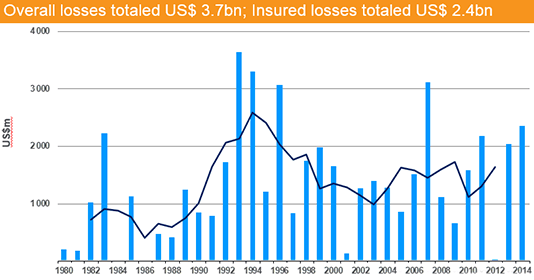Insurance and reinsurance broker Aon’s catastrophe risk modelling unit Impact Forecasting said that insured losses from the recent U.S. winter storms should be expected to be above average, however it is too early to provide any certainty on the impact to reinsurance programmes or even cat bonds.
In its latest weekly catastrophe update report Impact Forecasting notes that the U.S. typically averages around $3.1 billion of economic losses due to winter weather each year, with around an average $1.8 billion being covered by insurance.
The chart below gives an idea of how U.S. winter storm insurance industry losses tend to average:

U.S. insured losses due to winter storms, 1980 - 2014 - Source: Munich Re, Geo Risks Research, NatCatSERVICE (via I.I.I.)
However, last year winter weather and storm insurance industry losses were thought to be significantly above average, with $1.5 billion attributed to the polar vortex alone and as much as $2.3 billion for the full-year.
With 2015 kicking off in much the same way as 2014, but perhaps with even more snow as witnessed recently, it is to be expected that winter storm insured losses will extend above the average once again.
Impact Forecasting says that the insurance industry is in for more of the same for 2015, with the start of the year’s freezing weather ensuring another above average impact from winter storms.
“While specific estimates cannot be provided at this time, it is highly likely – if not certain – that winter weather losses associated with snow, ice, freezing rain, high winds and frigid temperatures will be well above average in 2015,” the report explains.
However, those hoping for insured loss estimates to emerge quickly will likely be disappointed as; “It remains too preliminary to provide an economic and insured loss estimate for the month-long stretch of winter weather across the United States. Given the frequency, intensity and on-going nature of the events, it is going to take local governments, emergency management agencies and insurance assessors several weeks or months to fully gauge the scope of damage and losses that have been incurred.”
Initial estimates suggest that the record snowfall in Massachusetts could cost the state’s government over $100m, in terms of response and clean up, while the economic activity of the state could take a hit as large as $1 billion or more.
Of course the severe winter weather extends well beyond Massachusetts and given the constant nature of freezing conditions since the start of the year the overall economic impact will be high, resulting in another winter hit to insurers and perhaps some reinsurance companies too.
What about catastrophe bonds?
There are a number of catastrophe bonds which provide U.S. primary insurers with coverage against winter storm losses. The majority are triggered on a per-occurrence basis, and so much less likely to suffer any loss without a considerable hit to a single insurers loss experience. However it is the aggregate winter storm cat bonds that are without a doubt most exposed once again.
Cat bonds with tranches that trigger based on aggregate losses and that cover winter storm risks include USAA’s Residential Reinsurance 2012 Ltd. (Series 2012-1), Residential Reinsurance 2013 Ltd. (Series 2013-1) and Residential Reinsurance 2014 Ltd. (Series 2014-1). Of these three the 2014-1 cat bond is most exposed as it attaches at a lower level of losses.
The Class 10 notes of the ResRe 2014-1 cat bond attach at the lowest level of losses, but have a $50m franchise deductible which means any qualifying events would have to have a fairly major impact to the industry, or a region where USAA has particularly high market share, to come near troubling them.
So at the moment it is uncertain whether there could be any threat to cat bonds from the severe U.S. winter weather. The ResRe 2014-1 Class 10 notes look, in our opinion, to be the most at risk of increasing winter storm losses. However, it is more likely that winter storm losses would more likely be a contributing factor to overall aggregate losses if these notes were ever to become at risk of principal losses over the entire risk period.
So there could be some aggregate layer erosion due to winter storms if the cat bond exposure turned out to be high, but it would likely take a combination of losses over the year from other perils to trouble investors, we’d imagine.
At more risk than these cat bonds would likely be reinsurance programs of regional insurers that have a high concentration of policies in affected, northeastern areas. Some of these reinsurance programmes could have collateralized capacity from ILS funds within them, it’s impossible to say. But that is more likely to trouble ILS investors than the high attachment, remote loss scenario of most of the exposed cat bonds at this time.
A.M Best recently noted:
Most insurers are likely weeks, if not months, away from knowing their total insured losses.
It is too early to determine if insurers in the region impacted by the recent snow storms will exceed their catastrophe reinsurance retention. It should be noted that small geographically concentrated insurers are more likely to exceed the retention on their catastrophe programs. Therefore, it is questionable whether reinsurance recoveries will provide significant profitability relief to these insurers.
We will update you once estimates become available, however that will be some time away as many claims are likely to be filed as the snow melts and while freezing temperatures remain a feature of U.S. weather patterns that is unlikely to be a quick process.
 View all of our Artemis Live video interviews and subscribe to our podcast.
View all of our Artemis Live video interviews and subscribe to our podcast.
All of our Artemis Live insurance-linked securities (ILS), catastrophe bonds and reinsurance video content and video interviews can be accessed online.
Our Artemis Live podcast can be subscribed to using the typical podcast services providers, including Apple, Google, Spotify and more.































